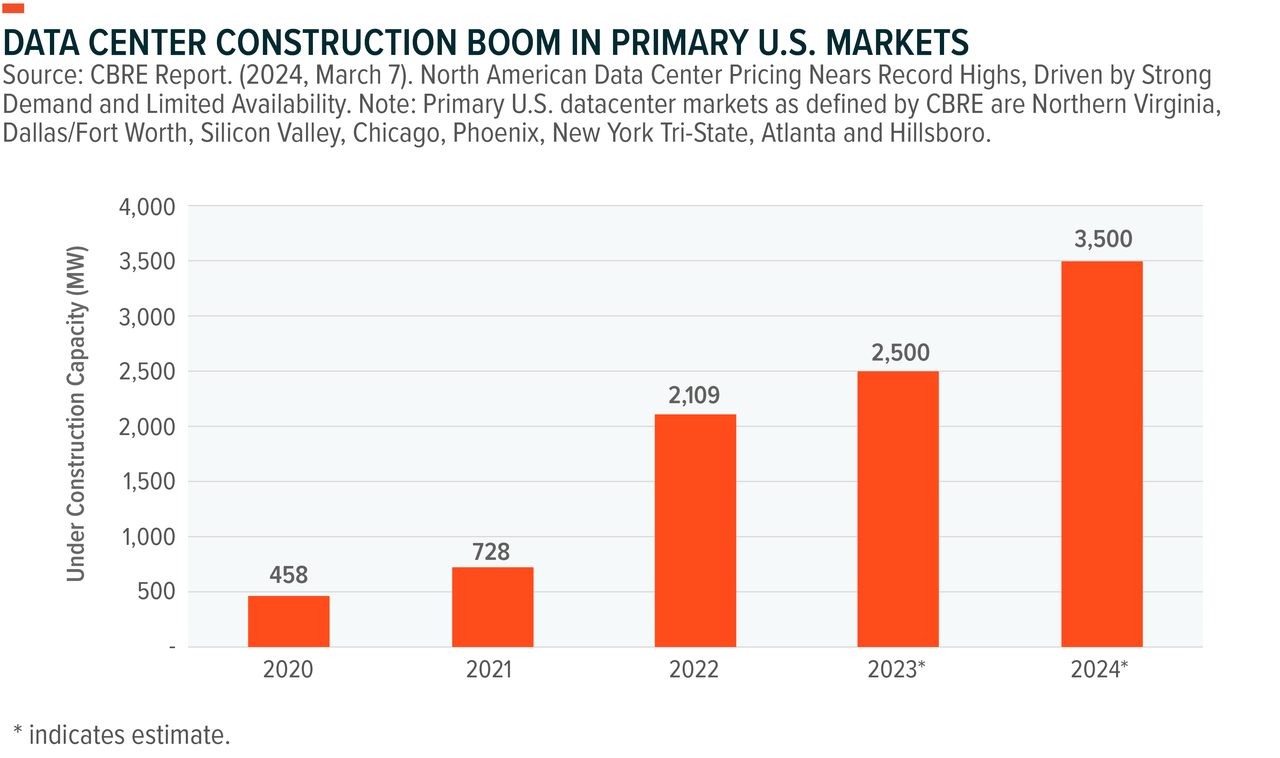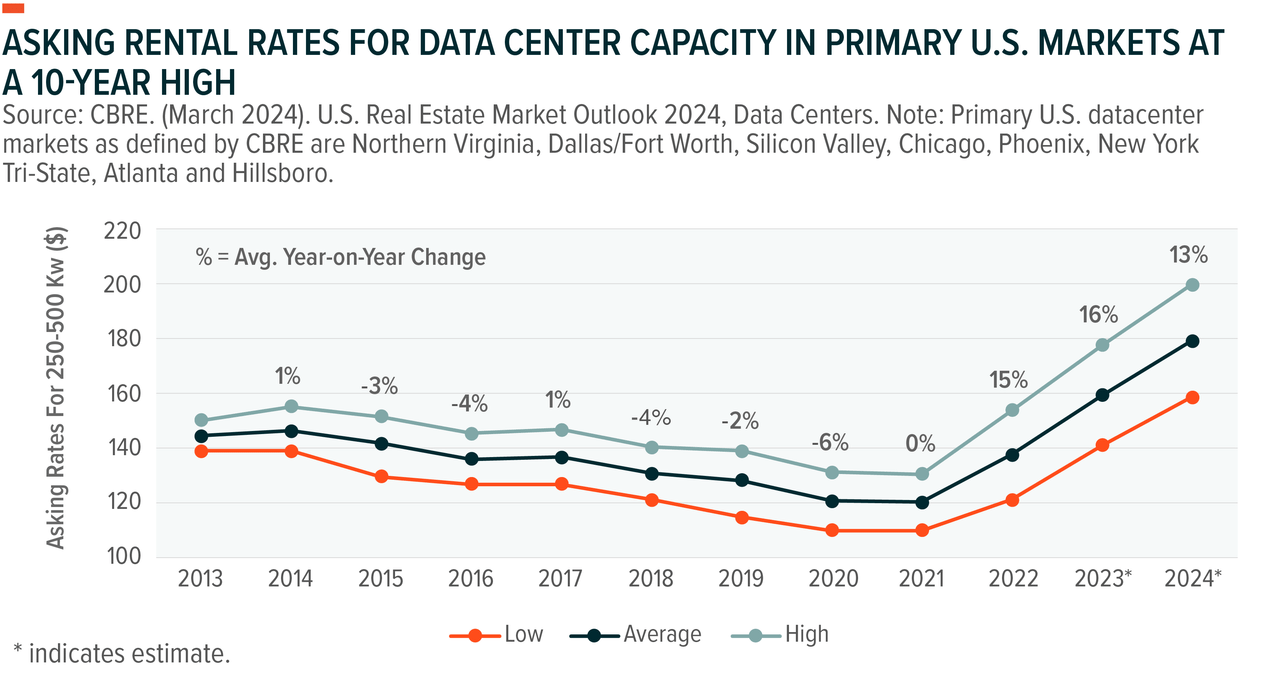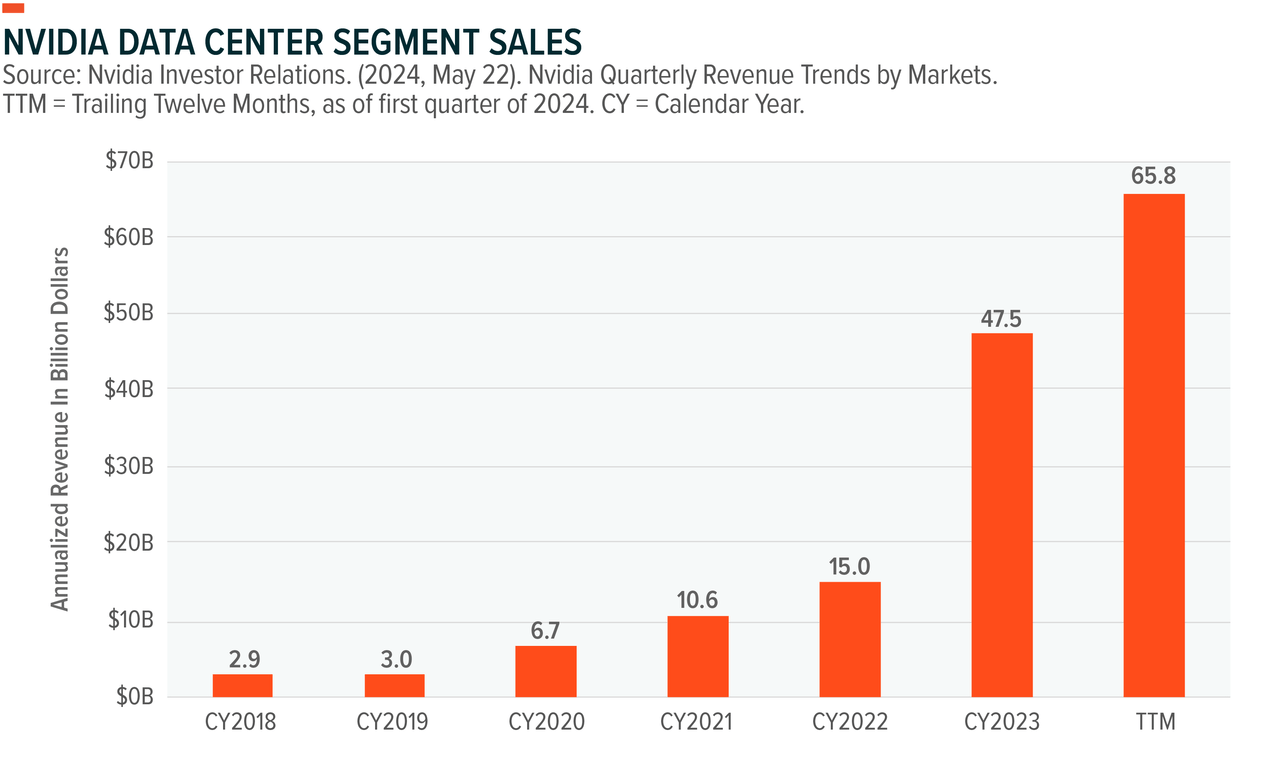Danai Jetawattana
Originally published on July 3, 2024
The generative AI boom extends far beyond chat assistants. The wider integration of large language models across various technology platforms and processes will need data centers and digital infrastructure capable of managing AI workloads effectively. As a result, new data center construction is increasing and existing data centers are being retrofitted with graphics processing units (GPUs) and other AI hardware, leading to premium leasing rates. Because AI-optimized data centers consume more power, stakeholders are also starting to address power sourcing, potentially with alternative energies like renewables and nuclear. To deliver AI to the average consumer, investments in cell towers and AI devices are expected to grow as well.
We view these dynamics as catalysts that can accelerate growth and boost earnings for the broad data center and digital infrastructure ecosystem. For investors, this means numerous opportunities to gain exposure to the AI paradigm shift.
Key Takeaways
- Industry stakeholders, led by hyperscalers, are rushing to invest in new data centers capable of delivering AI processing needs.
- New AI data centers and many existing data centers will be fitted with specialized AI hardware, creating opportunities for component suppliers and clean energy suppliers.
- Investments are likely to be ultimately directed towards enabling infrastructure such as cell towers and AI devices, which are needed for AI to achieve its potential at the consumer level.
AI Demand Spurs U.S. Data Center Construction Activity
In the United States, primary data center markets are expected to surpass 3,500 megawatts (MW) in construction activity in 2024, the highest level on record.1 In 2023, primary markets across the U.S. witnessed a nearly 25% year-over-year (YoY) increase in data center supply, reaching 5,174 MW.2 In Europe, a record 273 MW of new capacity is expected to be built this year.3
The Dodge Momentum Index (DMI), a widely used measure of the value of nonresidential building projects entering the planning phase, increased by 6.1% in April to 174.3, and another 2.7% in May to 179.0, largely driven by new data center projects4. Over 25 construction projects valued at $100 million or more in April, and an additional 19 projects in May, contributed to the DMI’s positive momentum5. Among the largest construction projects in planning stages for April are several data centers, including the billion-dollar Convergent Tech Park in Remington, Virginia, and the $630 million Dulles Digital Data Center in Dulles, Virginia.6 For the month of May, the DMI benefitted from a $495 million Prime Data Center in Fort Worth, Texas and another $481 million Prime Data Center in Garland, Texas.7
Meanwhile, vacancy rates for existing colocation-based data centers have reached record lows. According to CBRE, by the end of 2023, vacancy rates in primary U.S. markets fell to 3.7%.8 Simultaneously, rental rates for data center capacity in primary U.S. markets are expected to increase by 13% year-on-year (YoY) in 2024, underscoring the growing demand amidst a capacity crunch.9
Additionally, investing aggressively in new capacity to power their own technology platforms and cloud computing businesses are the hyperscalers. As of 2023, the hyperscalers operated nearly 992 data centers worldwide, with capacity doubling over the past four years.10 The big four, Amazon, Meta Platforms, Microsoft, and Alphabet, are expected to spend $200 billion on capital expenditures in 2024, an increase of more than 35% YoY.11
Amazon (AMZN, AMZN:CA) is planning an $11 billion investment for a data center complex in northern Indiana.12 Google (GOOG, GOOGL) is set to construct a $2 billion data center in Fort Wayne, Indiana, and spend an additional $1 billion to improve existing facilities in Virginia.13 Google’s also investing globally, with $1.1 billion going to build a data center in Finland and over $5 billion for data center expansion in Singapore.14 Meta (META, META:CA) is building a two-building data center on a 328-acre campus in Davenport, Iowa, and it’s embarking on a multibillion-dollar data center project in Cheyenne, Wyoming.15
AI Processing Creates Opportunities for New Hardware and New Energy
To process AI workloads, new data centers need a wide array of specialized hardware, which is creating unique tailwinds for specialized component providers. The most prominent example is Nvidia (NVDA, NVDA:CA). In just the last 12 months, Nvidia sold nearly $66 billion worth of GPUs to data centers, helping it ascend to the rarefied air of a $3.3 trillion market cap.16 We expect spending on data center accelerators alone to grow at a nearly 30% annual growth rate to top $165 billion by 2030.17
Broadcom (AVGO, AVGO:CA), one of the largest suppliers of AI networking solutions and application specific integrated chips (ASICs) for AI processing to companies like Meta Platforms and Alphabet, projects its AI segment revenues to grow by over 50% YoY to $11 billion in Fiscal Year 2024.18 Also, chipmakers Intel and AMD launched new products, including data center CPU chips, which are expected to be used widely for AI inferencing applications.19 Other prime examples of the infrastructure needed to support AI workloads include specialized cooling systems for data centers. High-capacity memory and fast storage solutions are also essential to handle the vast amounts of data processed by AI applications, such as those supplied by SK Hynix or Micron (MU).20
Another significant consideration with AI hardware growth is that it comes with severe power tradeoffs. An average ChatGPT query consumes 10 times more power than a regular Google search, resulting in an AI-first data center requiring nearly 2.5 times more electricity on average than a traditional data center.21 In primary U.S. data center markets, where new data center construction activity increased by 25% in first half of 2023, power supply demands increased 19.2% YoY.22
Data centers currently account for 1–1.5% of global electricity use, but by the end of this decade it’s expected to exceed 5%.23 Because conventional grids are unable to supply this increase, data center companies must resolve their power supply, which is a hurdle that can extend construction completion timelines by 24–72 months.24 Potential solutions include the use of nuclear and renewable energies. For example, Amazon recently acquired a $650 million data center project from Talen Energy close to a nuclear power station in Pennsylvania.25 Microsoft and Google joined hands for a partnership with Nucor to source geothermal, clean hydrogen, and other clean energy sources.26
Infrastructure Density and Enhanced Devices Crucial to Bringing AI to Users
Existing mobile connectivity infrastructure is insufficient to handle the massive amounts of data AI systems generate. Seamless connectivity and data transmission to end users requires an extensive expansion and enhancement of cell towers, particularly in dense urban areas. A likely growth segment is small cell towers, which can increase service densification. U.S. cell tower leader Crown Castle expects demand for small cell towers to grow significantly in 2024, even as the telecom industry braces for a 10% drop in capital expenditure.27 Crown Castle’s (CCI) small cell tower business grew 6% YoY in 2023.28
Edge data centers, along with content delivery networks (CDNs), are another segment that can play a crucial role in reducing latency and enabling AI systems to process data closer to end users and applications. Edge computing facilitates real-time processing and response that is vital for consumer applications and real-time connectivity.
Also, devices are likely to be optimized for AI. Local inference processing, where AI computations are done directly on the device, will become increasingly important. Smartphone giants like Apple (AAPL, AAPL:CA) are already moving in that direction. Apple’s latest announcements include the launch of Apple Intelligence, a device-based AI assistant capable of working only on Apple’s latest M-chip hardware and iOS 18.29 This development signals the likelihood of a smartphone upgrade cycle, which could catalyze growth for a long list of component vendors and device manufacturers. Laptops, wearables, internet of things systems, and industrial automation setups will require upgrades, including specialized low-power chips and components to efficiently handle AI tasks.
Conclusion: Data Center & Digital Infrastructure Value Chain Appear Well-Positioned
We believe that the digital infrastructure value chain presents highly investable opportunities as corporate investments in AI continue to grow. Data center companies can leverage newly built and enhanced AI processing capacity to upcharge and boost their sales and earnings. Chip and component manufacturers can benefit from an upgrade cycle in processing hardware and devices, fueled by growing construction of new data centers. Cell tower companies, edge computing platforms, and device makers will provide critical infrastructure. In our view, exposure to these pillars of the AI ecosystem offers an attractive way to play AI’s proliferation.
Footnotes
1CBRE Report. (2024, March 7). North American Data Center Pricing Nears Record Highs, Driven by Strong Demand and Limited Availability.
2CBRE Report. (2024, March 6). North America Data Center Trends H2 2023.
3CBRE Report. (2024, March 7). North American Data Center Pricing Nears Record Highs, Driven by Strong Demand and Limited Availability.
4Dodge Construction Network. (2024, June 7). Dodge Momentum Index Improved 3% in May.
5Dodge Construction Network. (2024, June 7). Dodge Momentum Index Improved 3% in May.
6Data Center Knowledge. (2024, June 5). New Data Center Developments: June 2024.
7Dodge Construction Network. (2024, June 7). Dodge Momentum Index Improved 3% in May.
8Sunbird. (2024, June 21). Colo Vacancy Rates Near Record Low: What Can You Do?.
9CBRE. (March 2024). U.S. Real Estate Market Outlook 2024, Data Centers.
10Synergy Research. (2024, April 17). Hyperscale Data Centers Hit the Thousand Mark; Total Capacity is Doubling Every Four Years.
11Forbes. (2024, May 9). Big Tech Q1 Earnings: AI Capex Increases As AI-Related Gains Continue.
12Reuters. (2024, April 25). Amazon to invest $11 billion in Indiana to build data centers.
13Reuters. (2024, April 26). Google plans $3 billion data center investment in Indiana, Virginia.
14Forbes. (2024, June 03). Google’s Singapore Investments Jump Five-Fold to $5 Billion.
15Data Center Dynamics. (May 21, 2024). Meta named as company behind 328-acre data center in Davenport, Iowa.
16Nvidia Investor Relations. (2024, May 22). NVIDIA QUARTERLY REVENUE TREND BY MARKETS
17Global X estimates, computed as of December 2023, with information from Precedence Research, 2023; Bloomberg, 2023; Statista, 2022.
18Reuters. (2024, June 12). Broadcom boosts revenue forecast from AI chips, unveils stock split.
19CNBC. (2024, June 3). AMD announces new AI chips amid intensifying competition with Nvidia, Intel.
20Forbes. (2024, June 10). AI is Driving Memory and Storage Demand and Production Introductions.
21Goldman Sachs. (2024, May 14). AI is poised to drive 160% increase in data center power demand.
22 CBRE. (2024). Data Centers, U.S. Real Estate Market Outlook 2024.
23Ibid.
24Goldman Sachs. (2024, May 14). AI is poised to drive 160% increase in data center power demand.
25Data Center Dynamics. (2024, March 04). AWS acquires Talen’s nuclear data center campus in Pennsylvania.
26Google, The Keyword. (2024, March 19). A new initiative with Microsoft and Nucor to accelerate advanced clean electricity technologies.
27RCR Wireless. (2024, January). Despite carrier capex contraction, Crown Castle sees ‘significant’ small cell demand.
28Ibid.
29Vox. (2024, June 11). Apple’s convincing case that AI doesn’t have to be scary.
This material represents an assessment of the market environment at a specific point in time and is not intended to be a forecast of future events, or a guarantee of future results. This information is not intended to be individual or personalized investment advice and should not be used for trading purposes. The selection of the index constituents and their weighting is made by the index provider at its sole discretion.
Shares of ETFs are bought and sold at market price (not NAV) and are not individually redeemed from the Fund. Brokerage commissions will reduce returns.
Investing involves risk, including the possible loss of principal. The companies in which AIQ invests may be subject to rapid changes in technology, intense competition, rapid obsolescence of products and services, loss of intellectual property protections, evolving industry standards and frequent new product productions, and changes in business cycles and government regulation.
Data Center REITs and Digital Infrastructure Companies are subject to risks associated with the real estate market, changes in demand for wireless infrastructure and connectivity, rapid product obsolescence, government regulations, and external risks including natural disasters and cyberattacks. DTCR is non-diversified.
International investments may involve the risk of capital loss from unfavorable fluctuation in currency values, from differences in generally accepted principles or from social, economic, or political instability in other nations. Emerging markets involve heightened risks related to the same factors as well as increased volatility and lower trading volume.
Carefully consider the funds’ investment objectives, risks, and charges and expenses before investing. This and other information can be found in the funds’ full or summary prospectuses, which may be obtained at globalxetfs.com. Please read the prospectus carefully before investing.
Global X Management Company LLC serves as an advisor to Global X Funds. The Funds are distributed by SEI Investments Distribution Co. (SIDCO), which is not affiliated with Global X Management Company LLC or Mirae Asset Global Investments. Global X Funds are not sponsored, endorsed, issued, sold, or promoted by Indxx, nor does Indxx make any representation regarding the advisability of investing in the Global X Funds. Neither SIDCO, Global X nor Mirae Asset Global Investments are affiliated with Indxx.
Editor’s Note: The summary bullets for this article were chosen by Seeking Alpha editors.




